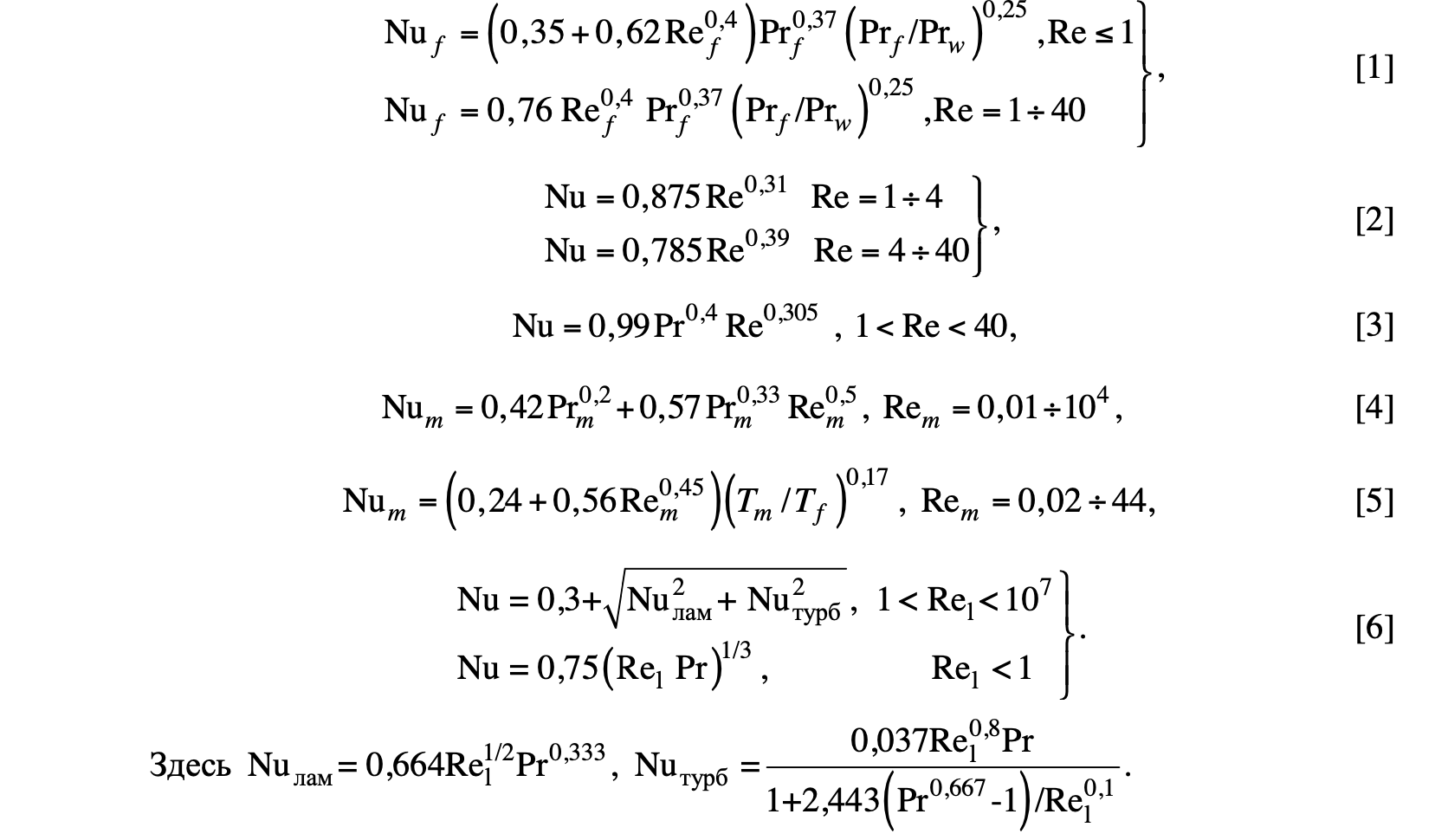@wikipedia
Dimensionless quantity characterising the ratio of thermal convection to thermal conduction in fluids across (normal to) the boundary with solids:
| LaTeX Math Block |
|---|
|
{\rm Nu} = \frac{\rm Convective \ heat \ transfer}{\rm Conductive \ heat \
transfer} = \frac{U}{\lambda / L} =\frac{U \cdot L}{\lambda } |
where
is the convective heat transfer coefficient of the flow, is the characteristic length, is the thermal conductivity of the fluid.
Stagnant Fluid
For Stagnant Fluid the Nusselt number is a constant number (OEIS sequence A282581):
| LaTeX Math Block |
|---|
|
{\rm Nu}=3.6568 |
Natural Convection
In Natural Fluid Convection becomes dependant on Rayleigh number
and Prandtl number : | LaTeX Math Inline |
|---|
| body | --uriencoded--\mbox%7BNu%7D = f (\mbox%7BRa%7D, \mbox%7BPr%7D) |
|---|
|
:
| LaTeX Math Block |
|---|
| \mbox{Nu}_D= \left[ 0.825 + \frac{0.387 \, \mbox{Ra}_D^{1/6}}{ \left[ 1+ (0.492/\mbox{Pr})^{9/16} \right]^{8/27}} \right]^2 |
| |
All convection regimes in pipelines
| LaTeX Math Inline |
|---|
| body | --uriencoded--\mbox%7BRa%7D_D \leq 10%5e%7B12%7D |
|---|
|
|
| LaTeX Math Block |
|---|
| \mbox{Nu}_L= 0.68 + \frac{0.663 \, \mbox{Ra}^{1/4}}{ \left[ 1+ (0.492/\mbox{Pr})^{9/16} \right]^{4/9}} |
| |
Laminar convection
| LaTeX Math Inline |
|---|
| body | --uriencoded--\mbox%7BRa%7D \leq 10%5e9 |
|---|
|
|
In case of natural convection in the annulus the Nusselt number becomes also dependant on the annulus geometry:
| LaTeX Math Block |
|---|
| {\rm Nu}_{ann} = \frac{2 \cdot \epsilon({\rm Ra})}{\ln (r_{out}/r_{in})} |
|
where
Forced Convection
In Forced Fluid Convection the Nusselt number becomes dependant on Reynolds number
and Prandtl number :
| LaTeX Math Inline |
|---|
| body | --uriencoded--\mbox%7BNu%7D = f (\mbox%7BRe%7D, \mbox%7BPr%7D) |
|---|
|
.
| LaTeX Math Block |
|---|
| {\rm Nu}=3.66 + \frac{ 0.065 \cdot {\rm Re} \cdot {\rm Pr} \cdot {D/L} }{ 1 + 0.04 \cdot ({\rm Re} \cdot {\rm Pr} \cdot {D/L})^{2/3} } |
| |
Laminar flow in pipeline with diameter and length . |
| LaTeX Math Block |
|---|
| {\rm Nu}=0.023 \cdot \mbox{Re}_D^{3/4} \cdot \mbox{Pr}^{0.4} |
| |
Turbulent flow in pipeline | LaTeX Math Inline |
|---|
| body | --uriencoded--\mbox%7BRe%7D \geq 10,000 |
|---|
|
|
| LaTeX Math Block |
|---|
| {\rm Nu}=\frac{ (f/8) \, ({\rm Re} - 1000) {\rm Pr} }{ 1 + 12.7 \, (f/8)^{1/2} \, ({\rm Pr}^{2/3} -1) } |
| | | LaTeX Math Inline |
|---|
| body | --uriencoded--%7B\displaystyle 3000\leq \mathrm %7BRe%7D\leq 5\cdot 10%5e%7B6%7D%7D |
|---|
|
| LaTeX Math Inline |
|---|
| body | --uriencoded--0.5\leq \mathrm %7BPr%7D \leq 2000 |
|---|
|
is Darcy friction factor |
| LaTeX Math Block |
|---|
| {\rm Nu}=0.3 + \frac{0.62 \, \mbox{Re}^{1/2} \, \mbox{Pr}^{1/3} }
{\left[ 1+ (0.4/\mbox{Pr})^{2/3} \right]^{1/4}}
\left[ 1 + \left( \frac{\mbox{Re}}{282000} \right)^{5/8}\right]^{4/5} |
| | All flow regimes in pipelines | LaTeX Math Inline |
|---|
| body | --uriencoded--\mbox %7BRe%7D \cdot \mbox %7BPr%7D \geq 0.2 |
|---|
|
Accuracy | LaTeX Math Inline |
|---|
| body | --uriencoded--\sim 20 \%25 |
|---|
|
|
Both numbers naturally arise in modelling the heat exchange between solid body and fluid.
Both numbers have similar definition except that Nusselt number is based on thermal conductivity of the fluid while Biot Number is based on thermal conductivity of the solid body.
Normally Nusselt number indicates whether conductive or convective heat transfer dominates across the interface between solid body and fluid.
While Biot Number indicates whether significant thermal gradient will develop inside a solid body based on the ratio of heat transfer away from the surface of a solid body to heat transfer within the solid body.
See also
Physics / Thermodynamics / Heat Transfer
[ Heat Transfer Coefficient (HTC) ] [ Heat Transfer Coefficient @model ]
[ Dimensionless Heat Transfer Numbers ]
[ Prandtl number ] [ Rayleigh number ] [ Reynolds number ] [ Biot Number ]
References
